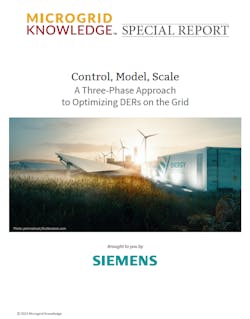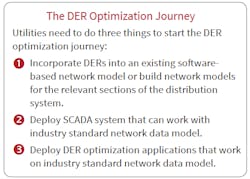In a new special report series, we explore how to optimize DERs on the grid. In this second installment, we outline how to star the DER optimization journey.
Many of the DERs coming onto the grid, such as solar PV systems, operate behind the meter, where utilities frequently have little ability to control them or even gain meaningful visibility. However, utilities can pilot the use of utility-owned microgrids to balance the impact of those other uncontrolled DERs.
To do so requires utilities to commission microgrids with control and data acquisition systems, which enable DER optimization.
When installed with control and data acquisition system software for DER optimization, microgrids can deliver critical value to the grid that almost every utility is seeking. One source of value is the microgrid data and visibility that allows the utility to develop useful models. Another is the control that turns the microgrid into a flexible load resource that can provide active and reactive power to utilities.
Because of this ability to provide flexible load, microgrids can help optimize things like power flows and voltages over feeders. For example, a portion of a utility’s grid might experience reverse power flow for a certain period of each day due to so many solar systems delivering power to a feeder. With DER optimization tools, a utility can communicate to a nearby microgrid to charge its battery systems during that period of the day to help manage the reverse power flow.
In essence, DER optimization tools manage microgrids and other DERs that can help manage overall grid health.
A portion of a utility’s grid might experience reverse power flow for a certain period of each day due to so many solar systems delivering power to a feeder. With DER optimization tools, a utility can communicate to a nearby microgrid to charge its battery systems during that period of the day to help manage the reverse power flow.
Duke Energy recently announced a project to put a microgrid to such a use. The utility is building a depot for electric vehicle (EV) fleet charging in North Carolina that will be served by power from the grid and Duke’s Mount Holly microgrid, located nearby. Duke wants the depot to serve as a model for reliable commercial- grade charging. The microgrid’s resources will include:
- Solar
- Energy storage
- Microgrid controls
- Optimization software
The difference between conventional controls and controls for DER optimization
Many DER control systems in the field today use an
ad-hoc approach to DER management. Certain rules drive the control of the DERs to prevent reverse power flow or overloads. If there are changes to the network configuration, such as the addition of new DERs, or a change in the feeder configuration, the control scheme is affected and requires onerous intervention such as a change in software.
DER optimization uses a “model-based” approach that circumvents the need for cumbersome software updates. When a new DER is added to the network, the operator updates the network model without the need for a cumbersome control software update. Software from Siemens accomplishes this by providing the engineer with separate tools for network model management and DER optimization.
To recap, using smart microgrid controls for DER optimization delivers a clear set of benefits for utilities that need cost-effective solutions to transition to the resilient grid of the future, including:
- Maximum renewable generation in the network while respecting network constraints.
- The ability to make network changes without having to restart the system.
- Minimal vender dependency due to easy-to-use network modeling software.
Download the full report “Control, Model, Scale: A Three-Phase Approach to Optimizing DERs on the Grid” courtesy of Siemens to learn more.










